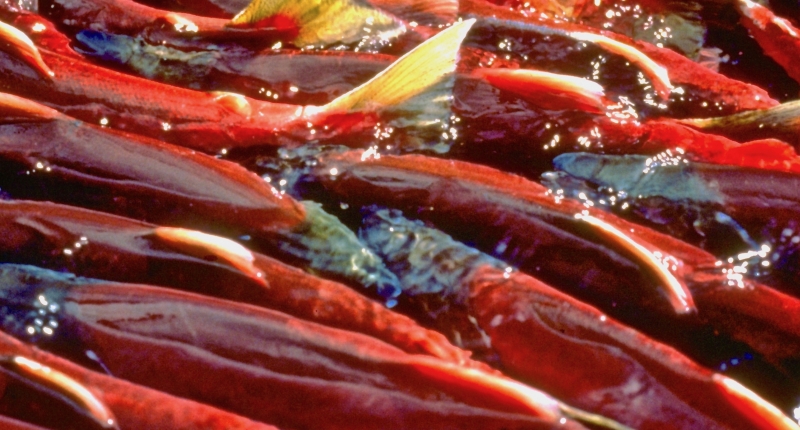Too Many Salmon in the Sea?

The notion that there can be too many salmon in the sea might seem preposterous, especially given how many people love to eat them, but according to a new study, there is a record-level abundance of certain species of North Pacific salmon, and it may be contributing to a troubling trend: depleting stocks of other salmon species, especially the prized Chinook salmon.
The study, published April 4th in the journal Marine and Coastal Fisheries, shows the number of pink, chum and sockeye salmon have been more abundant during the past 25 years than they have ever been since 1925, when the recordkeeping began. In the ten-year period of 2005 to 2015, an average of 721 million salmon were swimming in the sea each year, which is approximately 36 percent more than their previous peak in the late 1930s.
"While it is good that the abundance of sockeye, chum, and pink salmon is high, there is growing evidence that this high abundance, especially of pink salmon, is impacting the offshore ecosystem of the North Pacific and Bering sea,” said lead author Greg Ruggerone, a scientist at Natural Resources Consultants, INC. “These impacts may include the decline of higher trophic species of salmon, such as Chinook salmon in Alaska, the size, age and abundance of which has declined in recent decades even though their habitat is largely intact.”
All species of Pacific salmon migrate thousands of kilometers through the open ocean in search of food, and the abundance of pink, chum and sockeye in the northern regions may be due to more favorable waters. Not only is habitat in the north less degraded than in other areas, the waters are also warming under climate change, making conditions cozier for them.
The authors’ estimates, which are based on the most comprehensive compilation of abundance data to date, accounted for salmon born in both natural conditions and hatcheries throughout their native range in Asia and North America. Hatchery-born salmon represented about 40 percent of the seafaring adult and immature salmon.
Most of these hatchery salmon are chum, which typically spend more years at sea than their fellow salmon species before returning to freshwater spawning grounds, the final destination of any uncaught salmon’s life journey.
Pink salmon were the most abundant overall, representing nearly 70 percent of all wild and hatchery Pacific salmon combined. While most pink are wild, the numbers born in hatcheries in the past 25 years have been exceptionally high at an average of 66 million adults per year, a number that exceeds total wild chum populations.
High overall abundance can be a good thing, especially when it constitutes mostly wild salmon, but the authors explain the tremendous abundance of hatchery salmon, especially of pink, may be causing the North Pacific to reach its carrying capacity.
For example, there is growing evidence that the highly dense populations of pink – the least desirable species for its small size, soft and pale meat and short shelf life – are impacting the growth and survival of the more prized, but less plentiful Chinook and coho.
Ruggerone explains their study highlights the importance of maintaining and improving efforts to monitor the numbers of hatchery salmon in fisheries harvests and spawning grounds to keep a better pulse on the status of wild salmon. Tagging or marking hatchery salmon to make them more identifiable when caught or spawning, as well as making the resulting data publicly available, are critical to preventing adverse effects on the growth and survival of wild salmon.
“Ultimately, we want fisheries agencies in all areas of the Pacific Rim to estimate the numbers of hatchery and wild salmon as a means to monitor wild salmon status,” said Ruggerone, adding that at the bottom line is the need to maintain habitat to support wild salmon abundance into the future.
This study is the first to emerge from the State of Alaska Salmon and People (SASAP) project, a partnership between the National Center for Ecological Analysis and Synthesis (NCEAS) and Anchorage-based Nautilus Impact Investing that is funded by the Gordon and Betty Moore Foundation.
